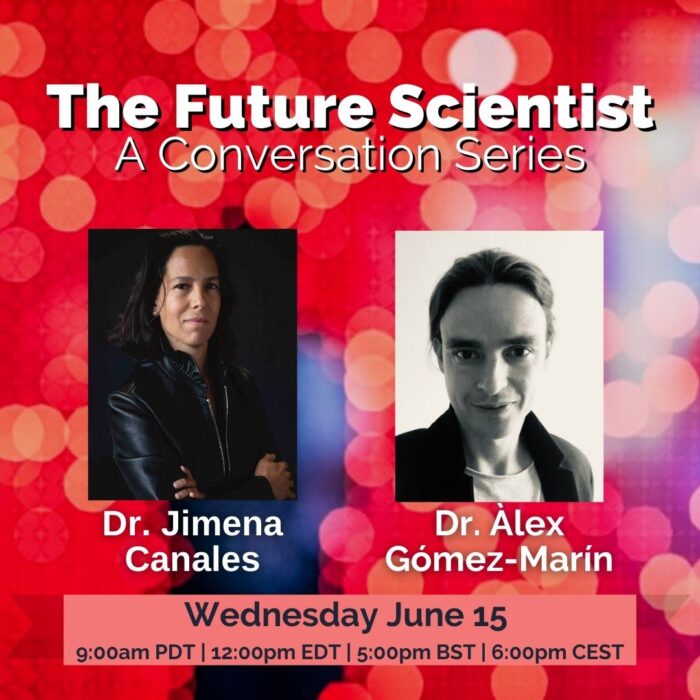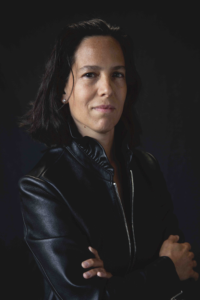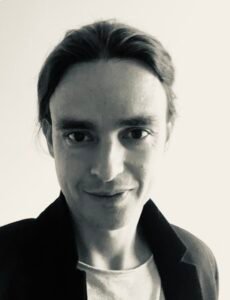Your cart is currently empty!

The Future Scientist – A Conversation with Dr. Jimena Canales
- This event has passed.
June 15, 2022 @ 6:00 pm – 7:30 pm CEST

A Conversation between Dr. Jimena Canales and Dr. Àlex Gómez-Marín
Wednesday June 15
9:00am PDT | 12:00pm EDT | 5:00pm BST | 6:00pm CEST
A monthly virtual encounter to understand where science is going and to reimage where we hope it might go.
The dialogue will be in a lively and spontaneous format of approximately 45 minutes up to an hour and we will then open up for questions from the audience.
Science is what scientists make of it in the context of their times. Therefore, to better understand its current state and its likely future, we must study its history. However, history is often written by the “winners”, and we swim in it like a fish oblivious to the kinds of waters that nourish (but also constrain) our understanding of the world. In this installment of The Future Scientist series, we will concentrate on the revolutions of physics at the dawn of the 20th century. The transformations of the very idea of science that ensued from certain ways of interpreting those advances percolated to biology and neuroscience all the way to the present moment. Drawing from major concrete historical events, we will discuss the very concept of measurement, the troubled relationship between the sciences and the humanities, and the crucial question of who has the authority to make claims about reality, and why. Although historians repeatedly learn that we hardly learn from history, a careful looking back can certainly offer a glimpse as to how to make the future science more scientific.

Dr. Jimena Canales is an award-winning author and scholar focusing on the history of science in the modern world. She is currently a faculty member at the Graduate College at the University of Illinois-Urbana, Champaign. She was previously the Thomas M. Siebel Professor in the History of Science at the University of Illinois and an Associate Professor at Harvard University. Canales is the author of A Tenth of a Second: A History, The Physicist and The Philosopher: Einstein, Bergson, and the Debate That Changed Our Understanding of Time, Bedeviled: A Shadow History of Demons in Science, and Simply Einstein. Her books have been voted Top 10 Books about Time (The Guardian), Best Science Books for 2015 (Science Friday, NPR, Public Radio International and Brainpickings), Top Reads for 2015 (The Independent), and Books of the Year for 2016 (The Tablet). Her scholarly work on the history of science has been published in Isis, Science in Context, History of Science, the British Journal for the History of Science, and the MLN, among others. Her work on visual, film and media studies has appeared in Architectural History, Journal of Visual Culture, and Thresholds. Canales writes frequently for general audiences publishing in The New Yorker, The Atlantic, Artforum, Aperture, Nautilus and WIRED among others. She has presented her work on science and art at the Pompidou Museum, SFMOMA, the 11th Shanghai Biennale, and the Serpentine Gallery in London. She was a senior fellow at the IKKM (Internationales Kolleg für Kulturtechnikforschung und Medienphilosophie).

Dr Àlex Gómez-Marín is a Spanish physicist turned neuroscientist. He holds a PhD in theoretical physics and a Masters in biophysics from the University of Barcelona. He was a research fellow at the EMBL-CRG Centre for Genomic Regulation and at the Champalimaud Center for the Unknown in Lisbon. His research spans from the origins of the arrow of time to the neurobiology of action-perception in flies, worms, mice, humans and robots. Since 2016 he is the head of the Behavior of Organisms Laboratory at the Instituto de Neurociencias in Alicante, where he is an Associate Professor of the Spanish Research Council. Combining high-resolution experiments, computational and theoretical biology, and continental philosophy, his latest research concentrates on real-life cognition and consciousness.
The Future Scientist Series
Science as we know it is a relatively recent human invention.
After the ‘scientific revolution’ of the seventeenth century, science and philosophy remained entangled as ‘natural philosophy’ until they started to separate in the nineteenth century (the very word ‘scientist’ was coined in 1834). Subsequently, science morphed from an activity carried out by wealthy people as a hobby (the ‘amateur,’ in the etymological sense of the word) into a paid job within an institutionalized system (the ‘professional’). Paradoxically or not, great ideas come more easily from people who are not paid to have them—it’s like forcing someone to be free, or compelling creativity by an act of will.
In the last decades, a series of technological and societal changes have further accelerated mutations of what it means to be a scientist; from the selection forces cast by neoliberalism on ‘scientific careers,’ to the kind of ‘science in the age of selfies’ that social media promotes. Scientists too are prey to the perverse dynamics of nowadays ‘attention economy.’ To understand what scientists do and why they do it, one must also understand the political and social contexts in which they live.
In addition, the rise of ‘big science’—initially in physics (particle physics and astronomy), and subsequently in life and mind sciences (genomics, and connectomics)—is reconfiguring the landscape typically inhabited by the romantic figure of the lone scientist receiving visions in dream-like states of consciousness and, eventually, advancing science in a stroke of genius. In turn, the idea of the scientist bred in the current academe is that of a diligent caffeinated deluxe technician as a part within the larger mechanism of research group army; a person trained exquisitely (and almost exclusively) on a research aspect, a specialist unable to keep track of what goes on beyond the narrow confines of his/her discipline. Young scientists are indeed trained to be good at following rules and procedures (explicit laboratory protocols, but also implicit codes of conduct and metaphysical commitments) but discouraged to learn to see when and how to transcend them.
In turn, the more recent promises of ‘big data’ and ‘artificial intelligence’ posit a near-future landscape where some of the core skills and tasks traditionally attributed to humans may be soon carried out by machines (or so the ‘scientific soteriologists’ claim). Algorithms are not just ingenious means to an end that require human intervention to imbue them with meaning, but are swiftly becoming ends in themselves, pretending they offer an automated unbiased interpretation of the data.
A re-appraisal of the habits of the modern scientist entails an ethical dimension as well: why do we treat animals as objects (as means, rather than ends in themselves), why do we study life in laboratories primarily by killing it, and why do we study life in laboratories in the first place? These questions also reflect on ecological considerations regarding our place in nature (humans in relationship with other animals, and other kingdoms of life) and our destruction of the planet. Francis Bacon’s prophetic vision of the Promethean scientist, so vividly captured in Mary Shelley’s Frankenstein, has become both a cautionary tale and an inspiration.
In addition, and despite the real ‘paradigm changes’ in physics at the beginning of the twentieth century, other branches of science such as biology and neuroscience remain under the spell of philosophical promissory materialism. Research facts are sold in tandem with covert metaphysical commitments. The objective-subjective divide still puzzles both scientists and the layperson. The mind-body problem remains to be solved (or dissolved).
In sum, the whole enterprise seems to be committed to suppressing broad thinkers, promoting academics that look more like corporate managers, PR mavericks and professional fund-raisers and less like scholars, who are asked to inhibit their interest in philosophy, and to cast suspicion on their fertile imagination. Dogma and habit are inhibiting free inquiry.
It is as if science as a whole is becoming less scientific.
In the face of this milieu of factors, in this series of online events we seek to reflect on what ‘the future scientist’ may look like. This is an ambitious exercise indeed, which goes beyond mere theoretical speculation. It is not unlikely that sooner than we think current science will be unrecognizable to most of us. The consequences for humanity writ large, not just for scientists themselves, are pressing.
The question at stake is whether by ‘future scientist’ we mean what scientists in the future are all likely to look like, or what a future better scientist might look like. In our conversations we will engage more in prescribing than in predicting, that is, we might begin by describing where science is going (prediction) to then describe where we hope science might go (prescription). Attempting the art of ‘dia-logos,’ we hope to express a creative voice that will enlighten the way of a new science in the twenty-first century.
The series will be direct conversations, that is, no formal presentation of the invited speaker but a kind of ‘thinking aloud’ in the mode of a dialogue between each guest and Àlex Gómez-Marín as the conversation host. The idea is to engage critically with various aspects of ‘the future scientist’ in a lively and spontaneous format for approximately 45 minutes to an hour, followed by comments and questions from the audience. Each conversation will take place virtually, on a Wednesday each month.
The invited speakers to The Future Scientist series are chosen not just as great interlocutors to discuss these issues, but also as exemplars and hints of what ‘the future scientist’ may actually look like here and now.
